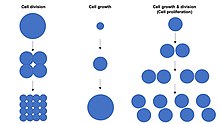This article needs additional citations for verification. (July 2020) |

Tissue growth is the process by which a tissue increases its size. In animals, tissue growth occurs during embryonic development, post-natal growth, and tissue regeneration. The fundamental cellular basis for tissue growth is the process of cell proliferation, which involves both cell growth and cell division occurring in parallel.[1][2][3][4]
How cell proliferation is controlled during tissue growth to determine final tissue size is an open question in biology. Uncontrolled tissue growth is a cause of cancer.
Differential rates of cell proliferation within an organ can influence proportions, as can the orientation of cell divisions, and thus tissue growth contributes to shaping tissues along with other mechanisms of tissue morphogenesis.
- ^ Conlon, Ian; Raff, Martin (1999). "Size Control in Animal Development". Cell. 96 (2): 235–244. doi:10.1016/S0092-8674(00)80563-2. ISSN 0092-8674. PMID 9988218. S2CID 15738174.
- ^ Grewal, Savraj S; Edgar, Bruce A (2003). "Controlling cell division in yeast and animals: does size matter?". Journal of Biology. 2 (1): 5. doi:10.1186/1475-4924-2-5. ISSN 1475-4924. PMC 156596. PMID 12733996.
- ^ Neufeld, Thomas P; de la Cruz, Aida Flor A; Johnston, Laura A; Edgar, Bruce A (1998). "Coordination of Growth and Cell Division in the Drosophila Wing". Cell. 93 (7): 1183–1193. doi:10.1016/S0092-8674(00)81462-2. ISSN 0092-8674. PMID 9657151. S2CID 14608744.
- ^ Thompson, Barry J. (2010). "Developmental control of cell growth and division in Drosophila". Current Opinion in Cell Biology. 22 (6): 788–794. doi:10.1016/j.ceb.2010.08.018. PMID 20833011.
© MMXXIII Rich X Search. We shall prevail. All rights reserved. Rich X Search
